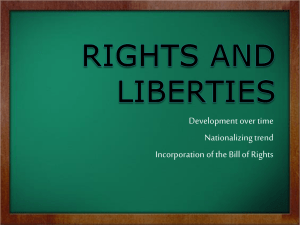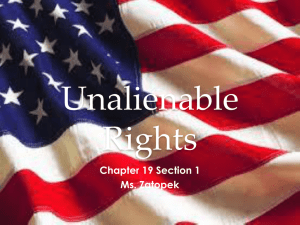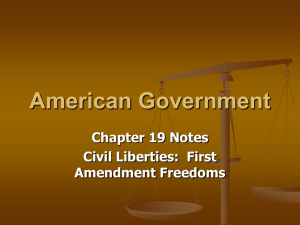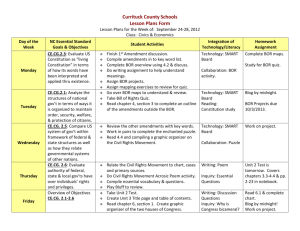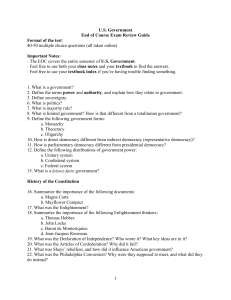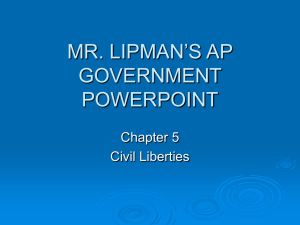Lecture Notes - workmanistan.com
advertisement
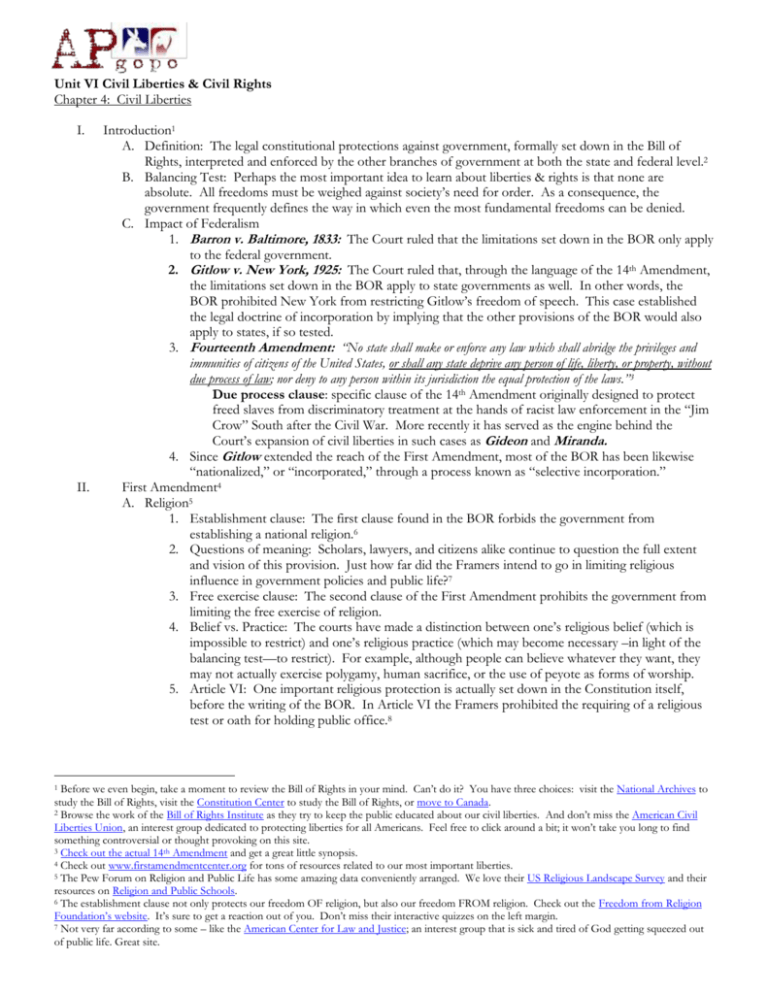
Unit VI Civil Liberties & Civil Rights Chapter 4: Civil Liberties I. Introduction1 A. Definition: The legal constitutional protections against government, formally set down in the Bill of Rights, interpreted and enforced by the other branches of government at both the state and federal level.2 B. Balancing Test: Perhaps the most important idea to learn about liberties & rights is that none are absolute. All freedoms must be weighed against society’s need for order. As a consequence, the government frequently defines the way in which even the most fundamental freedoms can be denied. C. Impact of Federalism 1. Barron v. Baltimore, 1833: The Court ruled that the limitations set down in the BOR only apply to the federal government. 2. Gitlow v. New York, 1925: The Court ruled that, through the language of the 14th Amendment, the limitations set down in the BOR apply to state governments as well. In other words, the BOR prohibited New York from restricting Gitlow’s freedom of speech. This case established the legal doctrine of incorporation by implying that the other provisions of the BOR would also apply to states, if so tested. 3. Fourteenth Amendment: “No state shall make or enforce any law which shall abridge the privileges and immunities of citizens of the United States, or shall any state deprive any person of life, liberty, or property, without due process of law; nor deny to any person within its jurisdiction the equal protection of the laws.”3 Due process clause: specific clause of the 14th Amendment originally designed to protect freed slaves from discriminatory treatment at the hands of racist law enforcement in the “Jim Crow” South after the Civil War. More recently it has served as the engine behind the Court’s expansion of civil liberties in such cases as Gideon and Miranda. 4. Since Gitlow extended the reach of the First Amendment, most of the BOR has been likewise “nationalized,” or “incorporated,” through a process known as “selective incorporation.” II. First Amendment4 A. Religion5 1. Establishment clause: The first clause found in the BOR forbids the government from establishing a national religion.6 2. Questions of meaning: Scholars, lawyers, and citizens alike continue to question the full extent and vision of this provision. Just how far did the Framers intend to go in limiting religious influence in government policies and public life?7 3. Free exercise clause: The second clause of the First Amendment prohibits the government from limiting the free exercise of religion. 4. Belief vs. Practice: The courts have made a distinction between one’s religious belief (which is impossible to restrict) and one’s religious practice (which may become necessary –in light of the balancing test—to restrict). For example, although people can believe whatever they want, they may not actually exercise polygamy, human sacrifice, or the use of peyote as forms of worship. 5. Article VI: One important religious protection is actually set down in the Constitution itself, before the writing of the BOR. In Article VI the Framers prohibited the requiring of a religious test or oath for holding public office.8 Before we even begin, take a moment to review the Bill of Rights in your mind. Can’t do it? You have three choices: visit the National Archives to study the Bill of Rights, visit the Constitution Center to study the Bill of Rights, or move to Canada. 2 Browse the work of the Bill of Rights Institute as they try to keep the public educated about our civil liberties. And don’t miss the American Civil Liberties Union, an interest group dedicated to protecting liberties for all Americans. Feel free to click around a bit; it won’t take you long to find something controversial or thought provoking on this site. 3 Check out the actual 14th Amendment and get a great little synopsis. 4 Check out www.firstamendmentcenter.org for tons of resources related to our most important liberties. 5 The Pew Forum on Religion and Public Life has some amazing data conveniently arranged. We love their US Religious Landscape Survey and their resources on Religion and Public Schools. 6 The establishment clause not only protects our freedom OF religion, but also our freedom FROM religion. Check out the Freedom from Religion Foundation’s website. It’s sure to get a reaction out of you. Don’t miss their interactive quizzes on the left margin. 7 Not very far according to some – like the American Center for Law and Justice; an interest group that is sick and tired of God getting squeezed out of public life. Great site. 1 B. Speech 1. More than Speech: The Court has expanded the concept of “speech” to encompass various forms of “expression.” In deciding which forms of expression to allow or restrict, the Court again must use the balancing test, weighing someone’s freedom of expression against society’s need for public order and safety, as well as national security. 2. Forms of expression that have been limited by the Court:9 a. Defamation b. Libel & slander c. Fighting words d. Clear and present danger e. Hate speech f. Incitement to crime g. Sedition h. Obscenity i. Disruptive of the learning environment in a public school C. Press 1. Questions of libel/slander/defamation (overlap with “expression”) 2. Questions of access: The perennial question of the freedom of press involves the media’s access to government information and/or secrets. This should remind you of executive privilege in the case of US v. Nixon, 1974. But it also includes topics like… a. Access to government documents (Freedom of Information Act, 1966 and 1996)10 b. Access to combat operations (“embedded journalists” in Iraq)11 c. Camera access to trials d. Right to protect anonymous sources e. Current controversies?12 D. Assembly and Petition 1. Limits: These freedoms have historically been less controversial, but also much easier to limit. State and local governments, for example, typically have been allowed to regulate the time, place, and manner of these activities (i.e., banning private property or requiring a permit). 2. Expansion: The Court has interpreted these protections to include the right to political association; i.e., join an interest group or political party. III. Rights of the Accused A. Colonial legacy: The majority of the protections in the BOR stem from bitter memories of the colonial experience. The heavy hand of British justice frequently violated basic and commonly accepted forms of due process in the colonies. As a result, the BOR dedicates specific limitations on the government’s power through every phase of the justice system: searches and seizures of property that may occur during an investigation (Fourth), procedures for arrests, detention, and questioning (Fifth), the nature of the trial (Sixth/Seventh), and the extent of the punishment (Eighth). B. Procedural vs. Substantive Due Process: The BOR protections for the accused person fit into two basic categories. First, the procedures followed by law enforcement from the time of the original arrest through the final sentencing must be fair. Second, the substance of the charges (the law in question) must itself be reasonable/constitutional. Any misstep in either category can jeopardize a conviction. In other words, law enforcement cannot violate your procedural or substantive due process. C. Areas of controversy 1. Arrest procedures 2. Warrantless searches13 3. Right to counsel 4. Self-incrimination At least that’s what the Constitution says. But if you’ve watched presidential campaigns lately you’ve probably noticed that a different sort of “religious test” seems to be gaining acceptance. I can’t wait to hear your opinion about this editorial written by Susan Jacoby, Pulitzer Prize winning (liberal) commentator for the Washington Post. 9 Here’s a great CRS report on exceptions to free speech. 10 Obama won some fans on his first day in office when he restored the integrity of the FOIA. 11 Here’s a quick primer on embedded journalists, courtesy of the NewsHour on PBS. 12 Obama appears to be flip-flopping on a campaign promise about releasing “state secrets” to the media on a case related to the Bush Administration’s alleged use of torture. 13 Read this NY Times article about a 13 year old girl stripped searched by school officials. Whoa. 8 5. 6. 7. 8. IV. Exclusionary rule Interrogation methods Habeas corpus Sentencing (Eighth Amendment) Right to Privacy A. Origins: The Constitution and the BOR never actually specify a guaranteed protection of privacy. Instead, the concept of privacy has been “read into” the Constitution by the Court’s interpretation of the 4th, 9th, and 14th Amendments. B. Consequences: After privacy was established (Griswold) it became the precedent that gave rise to a woman’s right to choose an abortion (Roe); undoubtedly one of the most explosive and divisive issues in American politics. Chapter 5: Civil Rights I. Introduction A. Definition: Policies designed to protect people against discrimination. Although so much of our political heritage is founded on the concept of “equality,” our government has a long history of withholding equality from certain elements of society. B. Major categories of discrimination: 1. Racial 2. Gender 3. Other: age, disability, sexual orientation, religion, etc. C. Balancing Test: Perhaps the most important idea to learn about liberties & rights is that none are absolute. All freedoms must be weighed against society’s need for order. As a consequence, the government often restricts the rights of some in order to protect the rights of others. D. Fourteenth Amendment: “No state shall make or enforce any law which shall abridge the privileges and immunities of citizens of the United States, or shall any state deprive any person of life, liberty, or property, without due process of law; nor deny to any person within its jurisdiction the equal protection of the laws.” Equal protection clause: specific clause of the 14th Amendment originally designed to protect freed slaves from discriminatory state laws in the “Jim Crow” South after the Civil War. More recently it has served as the engine behind the Court’s expansion of civil rights in such cases as Brown. E. Standards and Classifications: When a discrimination case comes before the Court, the justices apply different standards to each of the three classifications (race, gender, other).14 II. Historical Struggles for Equality A. African Americans 1. Constitution & Bill of Rights 2. Scott v. Sandford, 1857 3. 13th, 14th, and 15th Amendments 4. Plessy v. Ferguson, 1896 These brief lists include the milestone 5. Civil Rights Act of 1964 legislation/court cases in the historical struggle 6. 24th Amendment for equality. Admittedly, the list is incomplete 7. Voting Rights Act of 1965 as a historical study, but (if you take the time to 8. UC Regents vs. Bakke, 1978 look these up in your textbook) it is sufficient B. Women for the AP Exam on government. 1. 19th Amendment 2. Civil Rights Act of 1964 3. Equal Rights Amendment of 1972 4. Title IX of the Education Act of 1972 5. UC Regents v. Bakke, 1978 6. Medical and Family Leave Act of 199315 C. Asian Americans This is best explained in Lineberry, page 140, and Table 5.1 on page 141. Passed during the Clinton years, this law requires employers to grant leave of absence for employees who are seriously ill, have newborn or newly adopted babies, or who have to care for sick children, spouses, or parents. It was considered a major step forward for labor rights, but especially for working women who traditionally make the most professional sacrifices in the name of caring for family. 14 15 1. Korematsu v. U.S., 194416 D. Native Americans E. Hispanic Americans F. Recent additions to the list Rest assured this list will grow as society 1. Gay/lesbian becomes more inclusive and pluralistic, and 2. Disabled more groups lay claim to the promise of “equality” waiting for them in the “equal 3. Elderly & youth protection” clause of the 14th Amendment. 4. Muslims (post 9/11 racial profiling) III. Private Discrimination A. Definition B. Major Legislation 1. Civil Rights Act of 1964: Banned discrimination against any group in public accommodations (hotels, motels, restaurants, etc.) and employment/hiring practices.17 This law constituted the crowning achievement of Dr. Martin Luther King, Jr., is still seen as one of the most significant milestones in the civil rights movement of the 20th century, and is the birthplace of affirmative action policies later pursued by Congress and the Courts (see Bakke). 2. Education Act of 1972 (Title IX)18 3. Americans with Disabilities Act of 1990: Requires employers and public facilities to make “reasonable accommodations” for people with disabilities and prohibits discrimination against these individuals in employment.19 Here you’ll find a site dedicated to the PBS documentary of Fred Korematsu’s 40 year struggle for justice. You can watch the trailer and learn more about the story. 17 Review the basics of this law in Lineberry, page 146. 18 Review the basics of this law in Lineberry, page 480. 19 More in Lineberry, page 160. 16
